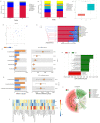Environmental enrichment changes rabbits' behavior, serum hormone level and further affects cecal microbiota
- PMID: 35287345
- PMCID: PMC8917805
- DOI: 10.7717/peerj.13068
Environmental enrichment changes rabbits' behavior, serum hormone level and further affects cecal microbiota
Abstract
Many studies have shown that stress is associated with gut microbiota. Environmental enrichment (EE) could reduce stress in farm animals; however, limited information is available on the microbial community composition in rabbits raised with or without EE. This study aimed to identify EE influences on the behavior, serum hormonal levels, and cecal microbiota of rabbits. Two hundred Rex rabbits were segregated randomly within four cohorts (n = 50); reared for 76 d within standardized enclosures (non-enriched) or within cages containing a willow-stick (WS), rubber-duck (RD), or a can of beans (CB). The rabbits' ingestive, rest, locomotion, exploratory, grooming, and abnormal behavior were observed. The serum hormone levels for rabbits were measured, and cecal specimens were sequencedfrom the V3-V4 region using 16S rRNA amplicons. Environmental enrichment increased feeding and drinking time, promoted exploratory behavior, and reduced abnormal behavior in rabbits. Insulin-like growth factor 1(IGF-1) levels of the enriched cohorts were elevated in comparison to the control cohort. Serum cortisol level for CB cohort was markedly reduced in comparison to the control cohort (p < 0.05), while dopamine levels for CB cohort peaked. Further, we found that EE mainly affected the dominant microbiota. Several families, such as Erysipelotrichaceae, Tannerellaceae, Enterobacteriaceae, Burkholderiaceae, and Prevotellaceae were markedly reduced within the CB cohort. Bacteria such as Alloprevotella, Bifidobacterium, Enterobacteriaceae, Parabacteroides, and Erysipelatoclostridium were identified as having negative associations with the presence of serum cortisol. EE influenced rabbit behavior and serum hormonal levels, and CB enrichment was the most suitable for rabbits. Further, cecal microbiota composition and diversity were affected by CB enrichment. These findings suggested that CB could be considered for use in rabbit husbandry.
Keywords: Cecal microbiota; Environmental enrichment; Rabbit behavior; Rabbit husbandry; Rex rabbits.
©2022 Feng et al.
Conflict of interest statement
The authors declare there are no competing interests.
Figures




References
-
- Abdelfattah E, Karousa M, Mahmoud E, ELLaithy S, ElGendi G, Eissa N. Effect of cage floor type on behavior and performance of growing rabbits. Journal of Veterinary Advances. 2013;3(2):34–42. doi: 10.5455/jva.20130219032609. - DOI
Publication types
MeSH terms
Substances
LinkOut - more resources
Full Text Sources
Miscellaneous

